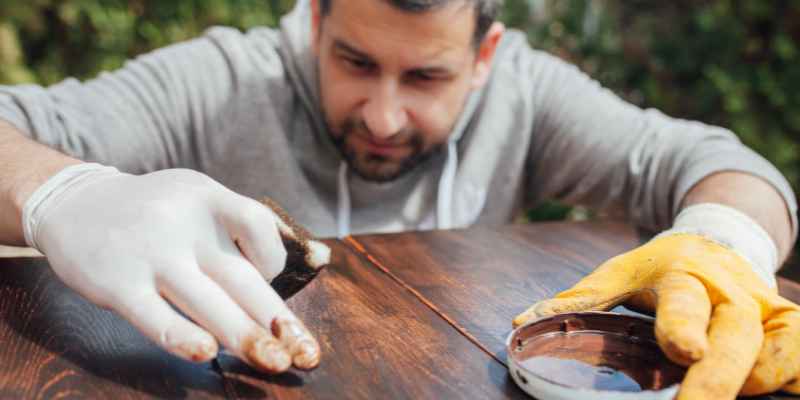To do French polishing on wood, start by preparing the surface with fine sandpaper. Apply a thin layer of shellac using a pad made from cotton or wool.
French polishing is a traditional wood finishing technique that enhances beauty while providing a high-gloss finish. Originating in the 18th century, it showcases the natural grain of the wood, making it a favorite among furniture makers and restorers. The process involves applying multiple thin coats of shellac, which is quick-drying and easy to work with.
This technique not only protects the wood but also adds depth and richness to its appearance. Mastering French polishing requires patience and practice, but the stunning results are well worth the effort. Unleash your creativity and transform your wooden pieces with this timeless skill.
Introduction To French Polishing
French polishing is a timeless technique. It enhances the beauty of wood surfaces. This method creates a rich, deep shine that attracts attention. Many artisans use this skill to restore old furniture. The process involves applying shellac in thin layers. Each layer adds to the shine and depth.
Historically, French polishing dates back to the 18th century. It gained popularity among furniture makers in Europe. This technique reflects craftsmanship and dedication. Many classic pieces feature this beautiful finish. Its significance lies in the artistry and patience required.
Today, many still admire the allure of French polishing. It brings out the natural grain of wood. The results are stunning and unique. This method remains a favorite for restoring antique furniture.

Essential Tools And Materials
Choosing the right shellac is key for French polishing. Use high-quality shellac for best results. Different colors and types are available. Pick one that suits your wood type.
The pad used in polishing is very important. A good pad helps apply the shellac evenly. Use a soft cloth or wool. Make sure it’s tightly wrapped for better control.
| Necessary Supplies | Purpose |
|---|---|
| Sandpaper | To smooth the wood surface |
| Brush | To apply shellac in hard-to-reach areas |
| Spirit | To thin the shellac if needed |
| Varnish | To finish and protect the wood |
Preparing The Wood Surface
Start by cleaning the wood surface. Use a soft cloth to remove dust and dirt. Next, sand the surface smoothly. Use fine-grit sandpaper for best results. This makes the wood ready for finishing.
Check for any imperfections on the wood. Look for scratches, dents, or rough spots. Fill these areas with wood filler. Sand again to ensure a smooth finish. This step is crucial for a beautiful result.
After preparing, apply a sealant. A sealant protects the wood and helps the polish stick better. Choose a suitable sealant for your wood type. Follow the instructions for the best outcome.
Mixing And Applying Shellac
To create the perfect shellac mix, start with flakes. Mix them with denatured alcohol in a jar. Use a ratio of 1:4 for a good balance. Shake the jar until the flakes dissolve completely.
For even application, use a soft cloth or a brush. Apply the shellac in thin layers. Work in the direction of the wood grain. This helps avoid streaks and bubbles.
Layering adds depth and protection. Allow each coat to dry before applying the next. Typically, three to five coats provide a beautiful finish. Lightly sand between layers for a smooth surface.
Mastering The Pad Technique
Building your pad is essential for French polishing. Use a soft cloth and fill it with shellac. Ensure the pad is not too wet or dry. This balance helps create a smooth finish.
The art of the swirl is crucial. Move the pad in small circles while applying the finish. This technique helps prevent marks and ensures an even coat. Keep the pressure light for the best results.
Controlling the finish requires practice. Start with a thin layer of shellac. Allow it to dry before adding more. Gradually build up layers to achieve a deep, glossy finish. Patience is key for a beautiful result.
Troubleshooting Common Issues
Streaks and smudges can ruin your beautiful wood finish. Use a clean, soft cloth to buff the surface gently. This often removes unwanted marks quickly and easily. If streaks remain, try a little extra polish to blend them away.
Drips and runs are common issues in French polishing. Allow the finish to dry completely before sanding the area lightly. After sanding, apply a thin layer of polish to fix the problem. Always work in thin coats to prevent drips.
A tired finish looks dull and lifeless. To revive it, clean the surface with a mild soap and water solution. Once dry, reapply a fresh coat of polish. This will bring back the shine and enhance the wood’s beauty.
Advanced Techniques And Tips
To achieve a high gloss finish, use a soft cloth and shellac. Apply thin layers and let each layer dry. Buff gently between coats for a smooth surface.
Mixing colors can create unique finishes. Combine different shades of shellac for a custom look. Test the mixture on a scrap piece of wood before applying it.
French polishing curves and hard-to-reach areas can be tricky. Use a small pad for detailed work. Apply a gentle pressure and move in circular motions to cover every inch.
Maintaining And Caring For Your Finish
Regular upkeep is essential for a long-lasting finish on French polished wood. Reapply the polish every 6 to 12 months to keep the shine. Look for signs of wear like dullness or scratches.
Cleaning should be done gently. Use a soft, lint-free cloth to remove dust. Avoid using water as it can damage the finish. Instead, use a specialized cleaner made for French polish.
For polishing, apply a small amount of polish on your cloth. Buff the wood in a circular motion. This helps to restore the shine and protect the surface. Remember, less is more!

Frequently Asked Questions
What Is French Polishing In Woodworking?
French polishing is a traditional wood finishing technique. It involves applying multiple thin layers of shellac using a pad. This method creates a high-gloss finish while enhancing the wood grain. French polishing is ideal for fine furniture and antiques, providing a rich, warm appearance.
How Long Does French Polishing Take?
The time required for French polishing varies by project size. Typically, it can take several hours to several days. This includes preparation, application, and drying time. Patience is crucial, as each layer must dry before applying the next for optimal results.
Can I French Polish Over Existing Finishes?
Yes, you can French polish over existing finishes. However, ensure the old finish is clean and in good condition. Lightly sanding the surface may help the new finish adhere better. Always test on a small area first to avoid unexpected results.
What Materials Do I Need For French Polishing?
To French polish, you’ll need shellac, a polishing pad, and a lubricant like oil. Cotton or linen works well for the pad. Additionally, fine sandpaper can be used for surface preparation. Having a clean workspace and good ventilation is also essential for best results.
Conclusion
French polishing enhances the beauty of wood, giving it a rich, glossy finish. By following the steps outlined, anyone can achieve professional results. Regular practice will improve your technique. Remember, patience is key. Embrace the art of French polishing and enjoy transforming your wooden pieces into stunning works of art.

